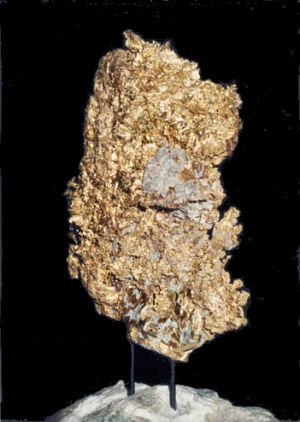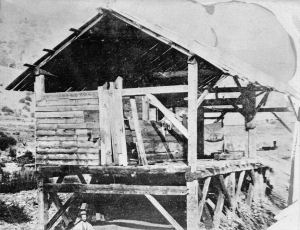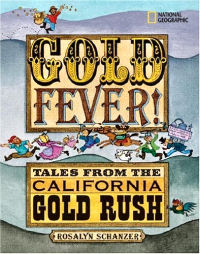California State Mineral and Mineralogic Emblem
| Native Gold |
|
Adopted:April 20, 1965 |
Adoption of the California State Mineral and Mineralogic Emblem
 |
| California State Mineral and Mineralogic Emblem: Native Gold |
The discovery of gold at Sutter's Mill in Coloma in 1848 and the subsequent gold rush of 1849 are as integral to the culture of California as the flora and fauna of the state.
Known as the Golden State, gold runs through California's symbols as it ran through its history; the golden poppy; the golden trout; the state colors; and the official gold rush ghost town, Bodie.
It was over forty years ago, 115 years after California had attained statehood, that Senator Luther Gibson of Solano County introduced Senate Bill No. 265 (SB 265) promoting California's native gold as the state's official state mineral and mineralogic emblem. In addition to a state mineral, SB 265 also proposed that serpentine be adopted as the state's official rock.
Newspapers of the time were not shy in their praise for the measure. The April 15, 1965 edition of The Fresno Bee, boasted confidently
Gold will assume its rightful place in the list of impressive state emblems. Already holding official designation are the bear flag, the valley quail, the redwood, the golden trout and the golden poppy.
Notably, they failed to include the state's magnificent state animal, the California Grizzly, in their list.
The Bee exposed its pride, concluding
California will be the first state to have an official state mineral and rock. This is fitting for the Golden State is first in so many things and mining is an important part of its economy.
There was some concern about serpentine as the state's official rock, but everyone, it seemed, was in favor of more gold.
First read in the Senate on January 27, 1965, SB 265 had been approved by both houses of the California Legislature by April 8th.
On April 20, Governor Edmond G. Brown signed Senate Bill No. 265, designating native gold as the official state mineral and mineralogic emblem and serpentine the official rock and lithologic emblem of the State of California.
CHAPTER 89
An act to add Sections 425.1 and 425.2 to the Government Code, relating to state emblems.
[Approved by Governor April 20, 1965. Filed with Secretary of State April 20, 1965.]
The people of the State of California do enact as follows:
SECTION 1. Section 425.1 is added to the Government Code to read:
425.1. Native gold is the official State Mineral and mineralogic emblem.
SEC. 2. Section 425.2 is added to the Government Code to read:
425.2. Serpentine is the official State Rock and lithologic emblem.
In September of 1965, in honor of the new official state mineral, the Bank of America featured a "huge gold display" in the gem and mineral building at the California State Fair.
California Law
The following information was excerpted from the California Government Code, Title 1, Division 2, Chapter 2.
CALIFORNIA GOVERNMENT CODE
TITLE 1. GENERAL
DIVISION 2. STATE SEAL, FLAG, AND EMBLEMS
CHAPTER 2. STATE FLAG AND EMBLEMS
SECTION 420-429.8
425.1. Native gold is the official State Mineral and mineralogic emblem.
Source: California State Legislature, California Law, , March 27, 2008.
Source: California State Legislature: Assembly Chief Clerk, Session Archives , March 27, 2008.
Source: The Fresno Bee, "Gold Has Arrived", April 15, 1965, Page 42.
Source: The Valley News, "Fair to Show New State Rock, Mineral", Sunday, August 1, 1965, Page 16.
Source: State Names, Seals, Flags and Symbols: A Historical Guide Third Edition, Revised and Expanded by Benjamin F. Shearer and Barbara S. Shearer. Greenwood Press; 3 Sub edition (October 30, 2001).
Additional Information
Gold!:
California Geological Survey.
Gold Fever:
Gold Rush! California's untold stories from the Oakland Museum of California.
Gold Rush History:
Articles from The Virtual Museum of the City of San Francisco.
Gold Rush: The Series:
From the Sacramento Bee.
Women in the Gold Rush:
Sponsored by award-winning author and recognized authority on women in the gold rush, JoAnn Levy, whose book, They Saw the Elephant: Women in the California Gold Rush, was praised by the San Francisco Chronicle as "one of the best and most comprehensive accounts of gold rush life to date."
State Rocks, Minerals, Gemstones, etc.:
Complete list of official state Rocks, Minerals, and Stones from NETSTATE.COM.
Gold Fever!: Tales from the California Gold Rush,
by Rosalyn Schanzer, Ages 9-12, 48 pages, National Geographic Children's Books (January 9, 2007) Using eyewitness accounts from the real men, women, and children of the gold rush, this absorbing picture book combines the words of the gold seekers and vibrant folk-art style paintings to make a memorable introduction to one of the most colorful chapters in American history. This overview, with its brief, digestible chunks, will likely tempt the appetites of budding historians, and the visual structure keeps the pace brisk.
The Age of Gold: The California Gold Rush and the New American Dream,
by H.W. Brands, 592 pages, Anchor (October 14, 2003) Texas A&M University professor H.W. Brands enhances his reputation as one of America's great popular historians with The Age of Gold, which tells the story of the California gold rush through rollicking narrative and intelligent analysis. "James Marshall's discovery of gold at Coloma [in 1848] turned out to be a seminal event in history, one of those rare moments that divide human existence into before and after," he writes. It launched "the most astonishing mass movement of people since the Crusades" and "helped initiate the modern era of American economic development."
They Saw the Elephant: Women in the California Gold Rush,
by Jo Ann Levy, 265 pages, University of Oklahoma Press (September 1992) In this exciting and inspiring account of the women who helped settle California, Levy explores the leadership roles of those who contributed to the founding of businesses, towns, and mining camps. Photographs, letters, and diary accounts contribute to the realism of these adventures.
With Great Hope: Women of the California Gold Rush,
by JoAnn Chartier, Globe Pequot Press; First edition (March 1, 2000) With Great Hope tells the fascinating stories of twelve uncommon women, the significant events of the times, and the everyday occurrences of life in the gold camps.
The Gold Rush Diary of Ramon Gil Navarro,
by Ramon Gil Navarro, 315 pages, University of Nebraska Press (October 1, 2000) Gold rush California was a rough and tumble world where finding gold--and keeping it--was not a simple matter. Navarro encountered people from all over the world brought together in a society marked by racial and ethnic intolerance, swift and cruel justice, and great hardships.
Contested Eden: California Before the Gold Rush,
by Ramón A. Gutiérrez (Editor), Richard J. Orsi (Editor), 395 pages, University of California Press; 1 edition (March 31, 1998) California before the Gold Rush, the first California Sesquicentennial volume, combines topics of interest to scholars and general readers alike. The essays investigate traditional historical subjects and also explore such areas as environmental science, women's history, and Indian history. Authored by distinguished scholars in their respective fields, each essay contains excellent summary bibliographies of leading works on pertinent topics.
A Golden State: Mining and Economic Development in Gold Rush California,
by James J. Rawls (Editor), Richard J. Orsi (Editor), 325 pages, University of California Press; 1 edition (June 1, 1999) California's storied Gold Rush triggered momentous changes not only for the state, but also for the nation and the world. The economic impact of that epoch-making event is the focus of the second volume of the California History Sesquicentennial Series. The Gold Rush was a multiplier, an event that accelerated a chain of interrelated consequences that in turn accelerated economic growth. But it also touched a deep-seated nerve in the human psyche and unleashed economic forces, for good or ill, that transformed California forever into a Golden State.
Rooted in Barbarous Soil: People, Culture, and Community in Gold Rush California,
by Kevin Starr (Editor), Richard J. Orsi (Editor), 384 pages, University of California Press; 1 edition (October 2, 2000) Perhaps never in the time-honored American tradition of frontiering did "civilization" appear to sink so low as in gold rush California. A mercurial economy swung from boom to bust, and back again, rendering everyone's fortunes ephemeral. Competition, jealousy, and racism fueled individual and mass violence. Yet, in the very midst of this turbulence, social and cultural forms emerged, gained strength, spread, and took hold. Rooted in Barbarous Soil,Volume 3 in the four-volume California History Sesquicentennial Series, is the only book of its kind to examine gold rush society and culture, to present modern interpretations, and to gather up-to-date bibliographies of its topics.
Taming the Elephant: Politics, Government, and Law in Pioneer California,
by John F. Burns (Editor), Richard J. Orsi (Editor), 299 pages, University of California Press; 1 edition (April 30, 2003) Taming the Elephant is the last of four volumes in the distinguished California History Sesquicentennial Series, an outstanding compilation of original essays by leading historians and writers. This fourth volume treats the role of post-Gold Rush California government, politics, and law in the building of a dynamic state, with influences that persist today. Provocative essays investigate the creation of constitutional foundations, law and jurisprudence, the formation of government agencies, and the development of public policy.
Hard Times in the Promised Land,
Gold Rush Era Music - Andy Alexis: lead and harmony vocals, clawhammer banjo, fretless banjo, guitar; Alan Beilharz Fuller: lead and harmony vocals, guitar, flamenco guitar; Dorothy A. Hawkinson: lead and harmony vocals, fiddle, hardingfele (Norwegian Hardanger fiddle), Fiddle and Banjo Records.
Places to visit
 |
Sutter's Mill: James Marshall in foreground
Credit: Library of Congress |
Marshall Gold Discovery State Historic Park:
Marshall Gold Discovery State Historic Park is the place where James W. Marshall found shining flecks of gold in the tailrace of the sawmill he was building for himself and John Sutter. This discovery in 1848 changed the course of California's and the nation's history..
Empire Mine State Historic Park:
Empire Mine State Historic Park is the site of one of the oldest, largest, deepest, longest and richest gold mines in California..
Bodie State Historic Park:
Bodie State Historic Park is a genuine California gold-mining ghost town (State Gold Rush Ghost Town). Visitors can walk down the deserted streets of a town that once had a population of 10,000 people.
Columbia State Historic Park:
The town's old Gold Rush-era business district has been preserved, with shops, restaurants and two hotels. Visitors have the chance to time-travel to the 1850s, imagining life when gold miners rubbed shoulders with businessmen and the other residents in Columbia.
|





